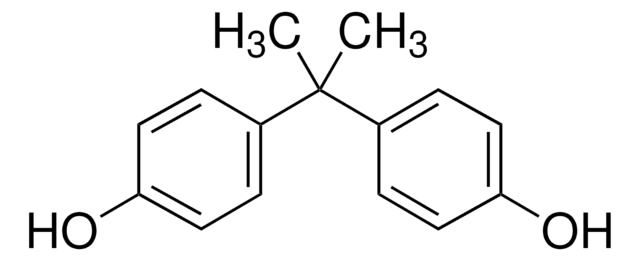73124
Bisphenol A (3-chloro-2-hydroxypropyl) glycidyl ether
analytical standard
Synonyme(s) :
2-[4-(3-Chloro-2-hydroxypropyloxy)pheny]-2-[4-(glycidyloxy)phenyl]propane, BADGE-HCl
About This Item
Produits recommandés
Qualité
analytical standard
Niveau de qualité
Essai
≥90% (HPLC)
Durée de conservation
limited shelf life, expiry date on the label
Technique(s)
HPLC: suitable
gas chromatography (GC): suitable
Application(s)
cleaning products
cosmetics
food and beverages
personal care
Format
neat
Température de stockage
−20°C
Chaîne SMILES
CC(C)(c1ccc(OCC(O)CCl)cc1)c2ccc(OCC3CO3)cc2
InChI
1S/C21H25ClO4/c1-21(2,15-3-7-18(8-4-15)24-12-17(23)11-22)16-5-9-19(10-6-16)25-13-20-14-26-20/h3-10,17,20,23H,11-14H2,1-2H3
Clé InChI
HLLOKZYCSSQYEB-UHFFFAOYSA-N
Description générale
Application
Conditionnement
Autres remarques
Mention d'avertissement
Warning
Mentions de danger
Conseils de prudence
Classification des risques
Eye Irrit. 2 - Skin Irrit. 2 - Skin Sens. 1
Code de la classe de stockage
10 - Combustible liquids
Classe de danger pour l'eau (WGK)
WGK 3
Point d'éclair (°F)
Not applicable
Point d'éclair (°C)
Not applicable
Équipement de protection individuelle
Eyeshields, Faceshields, Gloves, type ABEK (EN14387) respirator filter
Faites votre choix parmi les versions les plus récentes :
Déjà en possession de ce produit ?
Retrouvez la documentation relative aux produits que vous avez récemment achetés dans la Bibliothèque de documents.
Les clients ont également consulté
Notre équipe de scientifiques dispose d'une expérience dans tous les secteurs de la recherche, notamment en sciences de la vie, science des matériaux, synthèse chimique, chromatographie, analyse et dans de nombreux autres domaines..
Contacter notre Service technique

![Bis[4-(glycidyloxy)phenyl]methane mixture of isomers](/deepweb/assets/sigmaaldrich/product/structures/915/436/edb8eab6-834e-4238-a904-bf72c573b686/640/edb8eab6-834e-4238-a904-bf72c573b686.png)









